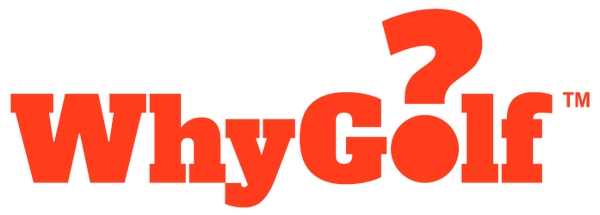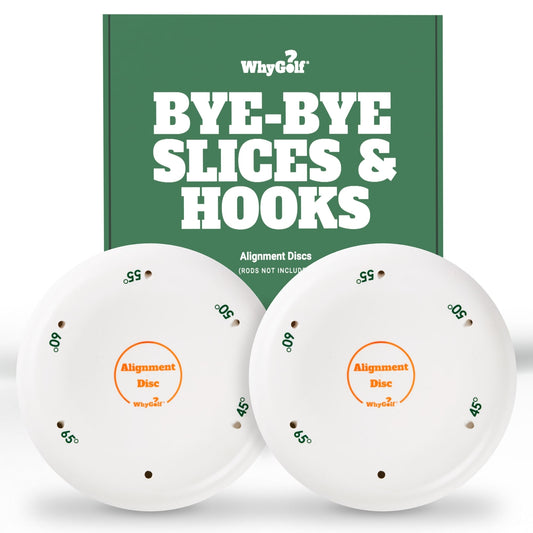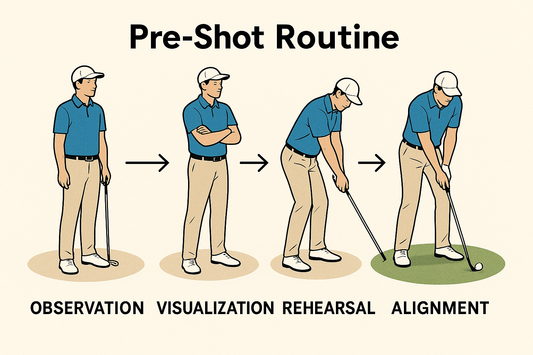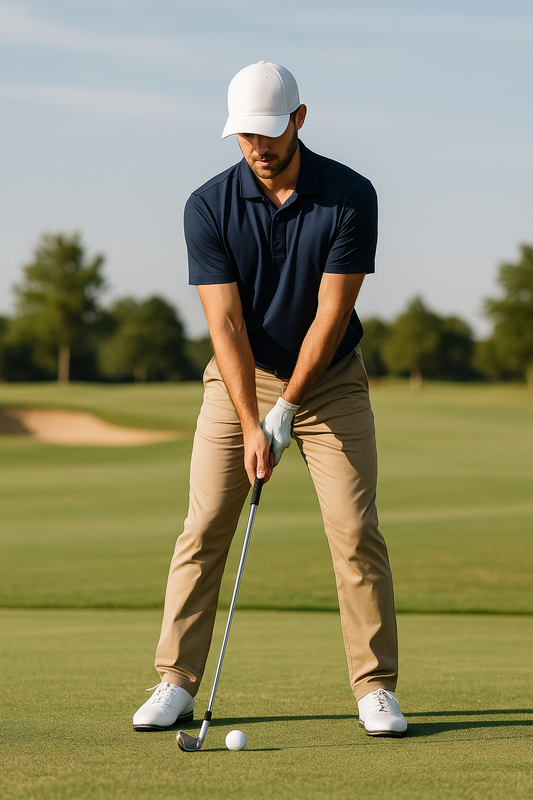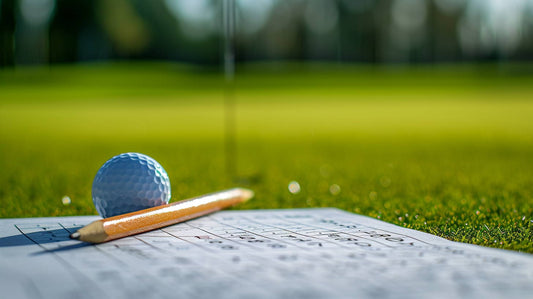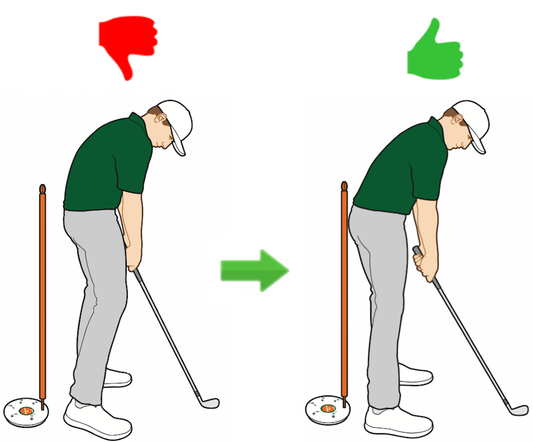Author: WhyGolf WhysGuy
We want to preface this guide with the acknowledgment that neither WhysGuy nor anyone from the WhyGolf team claims to know everything about the golf swing. We don’t want anyone to treat what we say here as gospel. While much of what we’ll say is a reflection of decades of dialogue with PGA instructors and players, we’re always learning and we understand that knowledge about the sport of golf will continue to evolve over time.
In this post, WhysGuy will cover:
- The difference between a draw vs. fade ball flight.
- How to hit a draw vs fade.
- WhysGuy's recommendations on learning how to hit draws vs. fades.
- How the Alignment Disc can help you hit draws and fades.
Benefits of Draws:
1. Draws penetrate wind much better than fades (draws make the ball spin less).
2. Draws generally go farther than fades. Since draws spin less than fades, they tend to roll out more.
3. Draws can help you safely access pins tucked to the left (right pins for left-handers). Instead of having to aim directly at a left pin, you'll be able to aim towards the center of the green and use draw spin to get closer to the hole.
Benefits of Fades:
1. Fades are generally easier to control than draws.
2. Fades land softer on greens due to increased spin. This allows you to be more aggressive when aiming at flag sticks.
3. Fades can help you safely access pins tucked to the right (left pins for left-handers). Instead of having to aim directly at a right pin, you'll be able to aim towards the center of the green and use fade spin to get closer to the hole.
How to Hit a Draw vs. Fade
Draws vs. fades happen when your swing path direction is slightly closed or open relative to your club's face angle at impact. Be sure to check out our Ball Flight Laws article, where we discuss in detail the 9 ball flights and the impact conditions necessary to hit each of them.
After you revisit the Ball Flight Laws, you can find articles about how to hit a draw and how to hit a fade.
Generally speaking, the simplest way to alternate between hitting draws vs. fades is to make simple adjustments to your golf setup and ball position. You can learn more about ball position here.
The rest of this article will include some unsolicited advice from WhysGuy about how to approach curving the golf ball.
How important is it to be able to hit draws vs. fades and at what point in my journey as a golfer is it worth learning how to hit it both ways?
WhysGuy's Unsolicited Advice about Hitting a Draw vs. Fade
A draw vs. fade can both be useful in their own ways, and there's no "better" ball flight. With this said, it's important for every golfer to figure out whether they're naturally better-suited to hit draws or fades.
If you're interested in learning how to hit both draws and fades, please consider the following three points:
1. It's really important to have a go-to ball flight. Whether you're playing for big money or you've got a tight tee shot with OB left and right, having a reliable "fairway finder" will take stress out of your game. It may be in your best interest to develop a go-to shot before you consider trying to shape the ball both ways on a consistent basis.
2. It will take time and dedication to get to a point where you can hit both a draw vs. fade consistently on the golf course. If you aren't playing golf at least once a week and spending time on the range, it may be wise to devote most of your attention to hitting one ball flight well (either a fade or a draw, depending on what is more comfortable for you).
3. If you haven't shot below 80 in your life, it's probably not worth actively trying to shape the ball both ways on the course. Stick to your preferred ball flight! It's entirely possible to hit just fades or just draws for an entire round of golf and shoot under par.
At the end of the day, we want golfers to enjoy the game as much as possible. For most, shooting lower scores is a primary source of joy. However, we acknowledge some golfers just want to hit cool golf shots (ie., hitting all the ball flights) and couldn't care less about scoring better. If this sounds like you, please ignore this section of this article. We won't take it personally.
Draw vs. Fade - Key Takeaways:
- There's no "better" ball flight - fades and draws are both useful in their own ways.
- Fades generally carry farther and land softer than draws. Draws roll more and usually go farther than fades.
- WhysGuy recommends that you perfect one shot shape (either a fade or draw) before you try to hit draws and fades consistently on the course.
- Consider using the Alignment Disc in your practice sessions to drill a draw vs. fade swing path.
Ready to make an investment in your golf swing? Learn more about how the Alignment Disc can help you learn how to shape the ball here.
What is a draw vs. fade?
Understanding the distinction between a draw vs. fade in golf is crucial for shot control. While a fade starts left of the target and curves right, a draw shot starts right of the target and curves back left.
A golfer needs an inside-out swing path to hit the ball from inside the target line and move it to the right after impact in order to achieve a draw. The ball acquires clockwise spin as a result, curving to the left.
A golfer needs to take an outside-in swing path to achieve a fade because it will cause the clubhead to approach the ball from outside the target line and move to the left after impact. The ball acquires counterclockwise spin as a result, curving to the right.
On the golf course, knowing how to hit both draw vs. fade shots is helpful because it enables players to work the ball around hazards or into the shape of the hole. However, perfecting these shots calls for practice and talent, and it's crucial to know when to use them properly.
Which ball flight is better?
There's no objectively "better" ball flight. Draws make more sense in some situations and fades can make more sense in others (course strategy post coming). We think it's most important for golfers to determine which ball flight (draw vs. fade) they feel most comfortable hitting. Once they've determined which ball flight they prefer, keep working on that ball flight until it's automatic.
How do I hit a fade?
We wrote an article about this. Click here to read it.
Here's the gist: a fade shot in golf requires an outside-in swing path, which causes the clubhead to approach the ball from outside the target line and move to the left after impact. This gives the ball counterclockwise spin, causing it to curve to the right.
The direction of the spin is what distinguishes a draw shot from a fade shot. A draw produces clockwise spin, whereas a fade produces counterclockwise spin. Focus on starting your backswing with your hands and arms slightly in front of your body to hit a fade. Feel as if you're pushing the club down and through the ball from the outside as you begin your downswing. This motion causes the clubhead to travel outside-in, resulting in the desired fade spin on the ball.
Another tip is to aim your clubface slightly to the left of your target at address to encourage your swing path to come from the outside. Also, finish your swing with your weight on your front foot and your body rotated towards the target.
Mastering the fade shot takes time and practice, but with proper technique and attention to swing path, you can become proficient in hitting draw vs. fade shots in golf.
How do I hit a draw?
We wrote an article about this. Click here to read it.
Here's the gist: golfers must use an inside-out swing path, which causes the clubhead to approach the ball from inside the target line and move to the right after impact, in order to hit a draw shot. The ball acquires clockwise spin as a result, curving to the left.
The direction of the spin is what distinguishes a draw vs. fade shot from eachother. While a fade imparts counterclockwise spin, a draw imparts spin in both directions. Focus on beginning your backswing with your hands and arms just slightly in front of your body if you want to hit a draw. Keep your hands close to your body as you start your downswing and imagine pulling the club through the ball from the inside. This movement encourages the clubhead to move in an inside-out direction, giving the ball the desired draw spin.
At address, aim your clubface slightly to the right of your target to encourage your swing to come from the inside. This is another helpful tip. Ensure that you finish your swing by shifting your weight to your front foot and rotating your body in the direction of the target.
You'll need time and practice to perfect the draw shot, but with the right technique and attention to swing path, you can improve your draw vs. fade shots.
What are golf's Ball Flight Laws?
Ball Flight Laws explain the 9 ball flights in golf and the impact conditions necessary to hit them. Read more here.
What's the main difference between a draw vs fade?
The draw vs. fade in golf describes the manner in which the ball curves after impact. A draw curves to the left for a right-handed golfer, while a fade curves to the right.
A draw is created by hitting the ball with a slightly closed clubface and an inside-out swing path - relative to the target. This change in direction affects the ball's spin axis, which ultimately causes the ball to turn left (right for lefties).
A fade is created by hitting the ball with a slightly open clubface and an outside-in swing path. This causes the ball to spin counterclockwise, which causes the ball to turn right (left for lefties).
Both draws and fades can be useful in specific circumstances. However, trying to consistently shape the ball both ways can be difficult even for the experienced golfer. Ideally, a golfer would focus on hitting one ball flight well before trying to move the ball both ways on a consisent basis. Why? Because in order to hit the ball both ways, your face/path relationship will have to change drastically to hit the desired ball flight. This is hard to do - even for the best players in the world.
Check Out Our YouTube Channel For Drills and Tips

